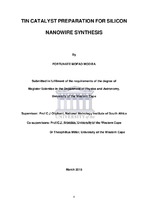| dc.description.abstract | Solar cells offer SA an additional energy source. While Si cells are abundantly
available they are not at an optimal efficiency and the cost is still high. One
technology that can enhance their performance is SiNW. However, material
properties such as the diameter, porosity and length determine their effectiveness
during application to solar cell technology. One method of growing SiNW uses Sn
catalysts on a Si substrate. As the properties of the Sn nanoparticle govern the
properties of the SiNW, this thesis investigates their formation and properties by
depositing a Sn layer on a Si wafer and then subjecting it to different temperatures,
during process the layer forms into nanoparticles. At each temperature the
morphology, composition and crystallinity will be determined using XPS, SEM, TEM
and EDS. Thus, in Chapter 1 there is an overview, Chapter 2 deals with techniques
used in this study, Chapter 3 will give the quantitative and qualitative results on the
XPS analysis and Chapter 4 will illustrate the structural behaviour of the annealed Sn
film samples. | en_US |

